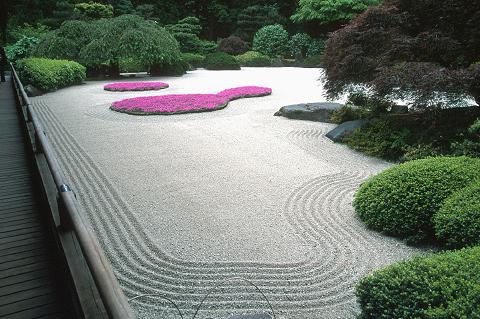Looking for inspiration from a Japanese sand garden? Learn about the history and symbolism of the Japanese sand gardens.
To many the Japanese concept of a sand garden almost void of any greenery seems awkward. Unorthodox as it may be the Japanese sand garden is a conceptual creation having its roots in ancient Japanese culture and a broader tradition of Japanese garden design.
The Japanese sand garden has a strong traditional association with Zen Buddhism. In fact it was the Zen temples that were the sanctuaries where this concept of a meditative sand garden evolved. Since the temples were surrounded by walls the monks created a tranquil environment that would help them to meditate.
The idea behind the creation of the sand garden was to symbolize nature using natural materials such as stones, sand and gravel. The graven was raked in order to create the illusion of rippling water. The use of plants was kept to the bare minimum.
Although the sand garden is actually representing water there is no real water in the whole composition. It is the raked gravel and sand that is taken as a symbolic representation of water instead. The stones are artistically composed in order to represent hills. The kind of rocks used may vary according to what exactly the designer aims to represent.
Similarly the raking of the sand and gravel is done in order to create different patterns. The patterns may vary from being straight lines to placid or swirling lines to suggest a flow and direction of water. The raking is done on a daily basis in a Japanese sand garden.
As much as the Japanese sand garden is about sand it is about stones. The use of the stones is done in a manner so as to suggest many different things. In some cases the positioning of the stones may actually be telling the tale of an ancient battle. In others the stones can be used to portray an image of a dragon.
Zen Sand Gardens
Since the concept of the sand garden revolves around Zen Buddhism you will find the tallest rock in the sand pit to be representing Buddha. The smaller stones accompanying the larger one are meant to be the children, followers, animals or other creatures.
The profound symbolism has its roots embedded in ancient Japanese culture. You will find there to be a nice garden bench strategically located in the garden to offer the visitor a chance to sit and observe the meditative sand garden. Traditionally the Japanese would never enter a sand garden. Rather they would observe it from the outside because entering the garden space would disturb the delicate composition.
The idea of the Japanese sand garden is taken by many westerners as an actual therapeutic remedy to achieve peace of mind. They have adopted this school of thought in total from ancient Japanese tradition. For others it is the mere aesthetic appeal and distinctive look of the Japanese sand garden that intrigues them.
Irrespective of what your beliefs are regarding the meditative qualities of the Japanese sand garden, one thing is for sure. The conceptual gardens have a timeless aesthetic value and the fondness of the global public is an attestation to that.





